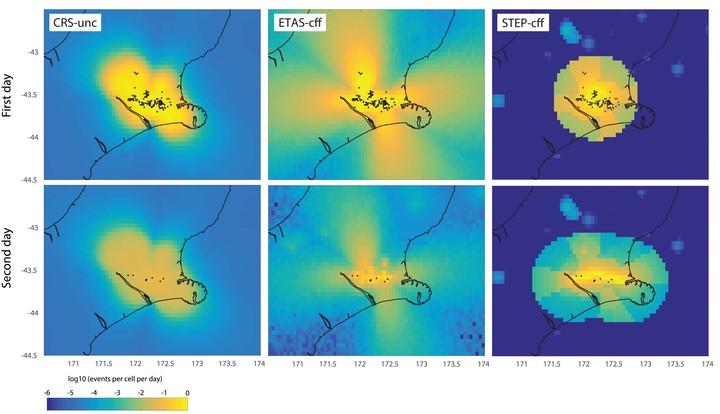Static stress triggering in operational earthquake forecasting
with Sebastian Hainzl and the Collaboratory for the Study of Earthquake Predictability (CSEP)
 Maps of daily forecast in the first and second day after the Darfield mainshock. From Cattania et al., 2018
Maps of daily forecast in the first and second day after the Darfield mainshock. From Cattania et al., 2018
Aftershock sequences take place after all moderate and large earthquakes, and are a significant source of hazard. A primary mechanism for aftershocks is the static deformation and stresses in vicinity of a mainshock. Physics-based models for Operational Earthquake Forecasting bring our physical knowledge of elasticity and friction into time-dependent, probabilistic earthquake forecasts.
Our approach has been guided by an attempt to construct physically consistent and realistic models of the processes involved, by including time-dependent (aseismic) fault slip and a realistic fault geometry. We found that deep afterslip following large subduction earthquakes significantly contributes to triggering seismicity on shallow crustal faults ( Cattania et al, 2015). Another outcome of this work is that stress heterogeneity due to the geometrical complexity of a fault system has a first-order impact in model behavior ( Cattania et al, 2014), and it significantly improves performance. This improvement was confirmed by a collaborative experiment carried out within CSEP for the aftershock sequence of the 2010 Canterbury (New Zealand) earthquake ( Cattania et al., 2018). In a collaboration with Simone Mancini (British Geological Survey/University of Bristol), Margarita Segou (BGS) and Max Werner (Univeristy of Bristol) we have further improved and tested these models, in the context of the 2016-2017 sequence in the Central Appennines (Italy).
External links: International collaboration studies the predictability of earthquakes on phys.org